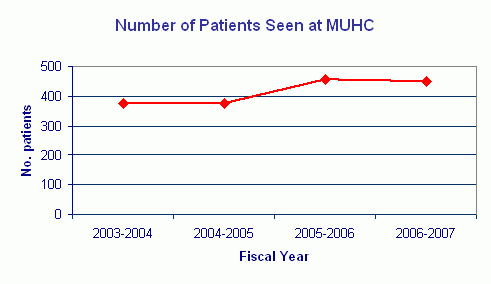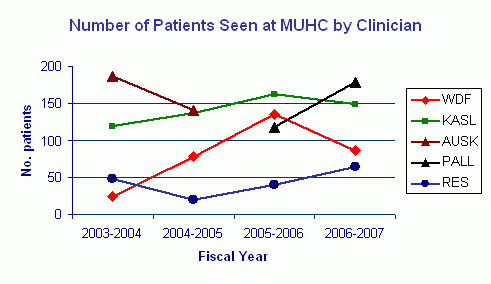|
Annual Report
2006/2007 Annual Report |
Annual
Report 2006/2007
The
Hess B. and Diane Finestone Laboratory in Memory of
Jacob and Jenny Finestone exists
in order to promote the field of medical genetics at
Dr.
William Foulkes and Dr. Marc Tischkowitz
demonstrated the involvement of PALB2/FANCN in hereditary breast cancer families.
Dr.
David Rosenblatt and his
collaborators have shown that mutations in the MCEE gene can result in elevated methylmalonic
acid excretion. With colleagues in the
Dr.
Patricia Tonin developed a derivative ovarian cancer cell line though the transfer of
chromosome 3 fragments, using a novel modification of an established technique
involving whole chromosome transfer. This cell line is now being used to
identify the underlying chromosome 3p gene(s) involved in tumour
suppression. A positive outcome has been the modulation of transcriptome
networks, which will enable them to prioritize gene candidates for an
independent project aimed at elucidating genes involved in ovarian tumourigenesis.
Dr. William Foulkes
was awarded a highly competitive Chercheur Nationaux Award from
the FRSQ.
Dr. Marc Tischkowitz was awarded a Chercheur Clinicien Award from the FRSQ.
Dr. Nicholas AhMew completed the RV year of his training program and
successfully passed the examinations of the
After more than five years, a Department of Medical Genetics was
finally established at the MUHC. Dr.
Teresa Costa has been appointed the first Chief of this hospital department.
Dr. Costa has held positions in the past in
In keeping with the new RUIS structure mandated by the Government
of
Clinical
Statistics:
Suzanne Dufrasne, M.Ps, Psychologist:
·
Number of new patients seen: 16
·
Number of sessions in person: 28
·
Number of counselling phone calls with patients (pre-session,
follow-up): 48
·
Number of counselling phone calls with health professionals: 20
·
Total number of interventions with patients: 76
Other Diseases (Creutzfeldt-Jakob, Familial adenomatous polyposis)
·
Number of patients seen: 2
Stephanie
Fox,
·
Number of new patients seen: 75
·
Number of follow-up patients seen: 80
·
Total cases seen: 155
Total Patients Seen at MUHC
·
2003-2004: 377
·
2004-2005: 376
·
2005-2006: 456
·
2006-2007: 451 (~20% increase since 2004-2005)


NOTES FOR LEGEND:
·
Fiscal periods are calculated from April 1st- March 31st.
·
Totals for KASL (Lidia Kasprzak) take into account all patients seen by KASL and/or
her replacements (SFOX [Stephanie Fox], MLAL [Maria Lalous],
LROB [Laura Robb]) over each financial period.
·
For 2005-2006 fiscal period, PALL (Laura
Palma) totals are calculated from time of start date
·
Stats for RES include the total number of patients seen by either
genetics residents and/or FITZJ (Jennifer Fitzpatrick)
Research
Interests and Accomplishments of Individual Members:
Dr. Eleanor Elstein has an active clinic in the area of cardiovascular
genetics, which evaluates inherited cardiac diseases as well as systemic
genetic diseases that have cardiac manifestations.
Dr. Ken Dewar and his laboratory are using genomics and bioinformatics technologies
to study genome structure and variation.
One focus of the lab is to develop genetic mapping tools for
investigating complex trait mapping in a nonhuman primate, the vervet monkey. Using
comparative genomics approaches they have leveraged other genome projects
(human, chimpanzee, rhesus monkey) to streamline the discovery of markers of
genetic variation (SNPs). They have also embarked upon the generation
of corresponding genome wide physical map, entailing the paired-end sequencing
and genome alignments for >200,000 BAC clones. The vervet BAC map
is being used to delineate chromosomal breakpoints and to identify vervet BAC clones associated with evolutionary recently
derived centromeres and pericentromeric
regions.
His group is also interested
in understanding genome structure and virulence factors in the human bacterial
pathogen Clostridium difficile. C. difficile remains a serious health risk in
Dr. William Foulkes and colleagues have been characterizing mutations in
the new breast cancer gene PALB2. In
addition, he has worked with BRCA1-mutated cell lines to try to develop novel
treatments. With George Chong, he has described several novel mutations in genes
associated with hereditary colorectal cancer. As mentioned above, in recognition of the excellence of his work, he has
been awarded a Chercheur Nationaux
award from the FRSQ.
Mary Fujiwara studies the distribution and maintenance of genetic variability,
including deleterious alleles, in populations.
During the current reporting period, she continued collaborations on the
Hutterite population of
She also collaborate
with Daniel Bichet (Hôpital
Sacré-Coeur de Montréal) on the genetics of nephrogenic and neurohypophyseal
diabetes insipidus. The study of mutations in three different
genes has shown that the mode of inheritance can differ based on the particular
mutation. They maintain locus specific
mutation databases for these genes which encode the hormone arginine
vasopressin, its receptor, and a water channel (AVP, AVPR2, and AQP2, respectively).
Dr. Brian Gilfix focuses
on two main areas of research: 1) Homocysteine and
its Metabolism/Inborn Errors of Metabolism (Homocystinuria)-they
have a large cohort of patients in the Adult Genetics Clinic with homocystinuria. He is using this opportunity to explore new
treatments of homocystinuria and investigate the
effect of elevated homocysteine on other risk factors
for cardiovascular disease; 2) Development of Laboratory Methods in Molecular
Diagnostics and HPLC-he is developing and implementing assays based on
hybridization probes to replace standard assays based on restriction fragment
length polymorphism used to genotype single nucleotide polymorphisms in the
clinical laboratory. The benefit of this is decreased net cost and faster
turnaround time.
Dr. Ken Morgan has a major interest in human population genetics and genetic
epidemiology. He is involved in the
genetic analysis of Mendelian and complex traits in
humans and mice. Accomplishments related
to human genetics include mapping rare Mendelian
diseases. Ongoing collaborations include
segregation and linkage analysis of intermediate phenotypes contributing to
calcium kidney stone formation; genetic susceptibility to inflammatory bowel disease
in children; and reducing the complexity of pedigrees in founder populations
such that statistical analysis is computationally feasible.
He is a member of the CIHR
Institute of Genetics Priorities and Planning committee for genetic
epidemiology and statistical genetics and was on the organizing committee of
the “Second Annual Canadian Genetic Epidemiology and Statistical Genetics
Meeting”, held in
Dr. David Rosenblatt and his laboratory continue to be the major
international referral source for the diagnosis of patients with inherited
disorders of folate and vitamin B12. They
are involved in studying the biochemical and molecular bases of these
diseases. This year they have expanded mutation
analysis among patients with combined homocystinuria
and methylmalonic aciduria
due to mutations in MMACHC. They have
also shown that mutations in the MCEE gene can result in elevated methylmalonic acid excretion. With colleagues in the
Dr Marc Tischkowitz has been establishing a research program at the Segal
Centre, Jewish General Hospital to undertake innovative and
effective research in the field of hereditary predisposition to cancer,
with a focus on the genetic links between breast cancer and Fanconi
Anemia. He was part of an international collaboration that identified
PALB2/FANCN as a new Fanconi Anemia gene and together
with Dr Foulkes he helped to establish that PALB2 is
a breast cancer predisposition gene.
Patricia Tonin works in two principal areas of research; these are
described on the web site: www.toninlab.mcgill.ca.
A. The Molecular study of Human Epithelial Ovarian Cancer
More than 70% of women
diagnosed with ovarian cancer die of the disease. Our knowledge of the
molecular events associated with the development and progression of epithelial
ovarian cancer has been limited by the lack of a suitable model system. Also,
since the disease is often diagnosed at a late stage when numerous complex
chromosomal changes have already taken place, the early molecular events remain
largely unknown. Research in the lab is focused on the identification of tumour suppressor genes, particularly those physically
associated with chromosomes 3p and 17q. Various molecular genetic techniques
are used to identify them, which include, allelic content analysis such loss of
heterozygosity studies and single nucleotide (SNP)
polymorphism analyses, large-scale gene expression assays (Affymetrix
platform), and more recently functional approaches based on chromosome transfer
fragment and gene complementation. A major accomplishment of the last year was
development of a derivative ovarian cancer cell line though the transfer of
chromosome 3 fragments. This cell line
was developed using a novel modification of an established technique involving
whole chromosome transfer. This cell line is now being used to identify the
underlying chromosome 3p gene(s) involved in tumour
suppression. A positive outcome has been the modulation of transcriptome
networks, which will enable them to prioritize gene candidates for an
independent project aimed at elucidating genes involved in ovarian tumourigenesis. [See News item at www.toninlab.mcgill.ca
for Press Release.]
In collaboration with
colleagues at the CHUM-Notre Dame, they investigate gene expression profiles of
ovarian cancer samples with the aim of identifying signature patterns of gene
expression in order to elucidate molecular pathways important in ovarian tumourigenesis.
B. Breast and Ovarian Cancer Susceptibility Genes
Hereditary breast and
ovarian cancer accounts for approximately 5-10% of all breast and ovarian
cancers. A large majority of cancer
families are attributed to germline mutations in
BRCA1 and BRCA2. However, about 40% of cancer families are negative for
mutations in these known genes. Dr. Tonin’s
group is also focused on determining the contribution of known and unknown
cancer susceptibility genes to inherited predispositon
to breast and ovarian cancer. They focus on the founder French Canadian
population of
Members
| Report | Meetings
Publications
| Funds | Financial
© 2007 Finestone Laboratory